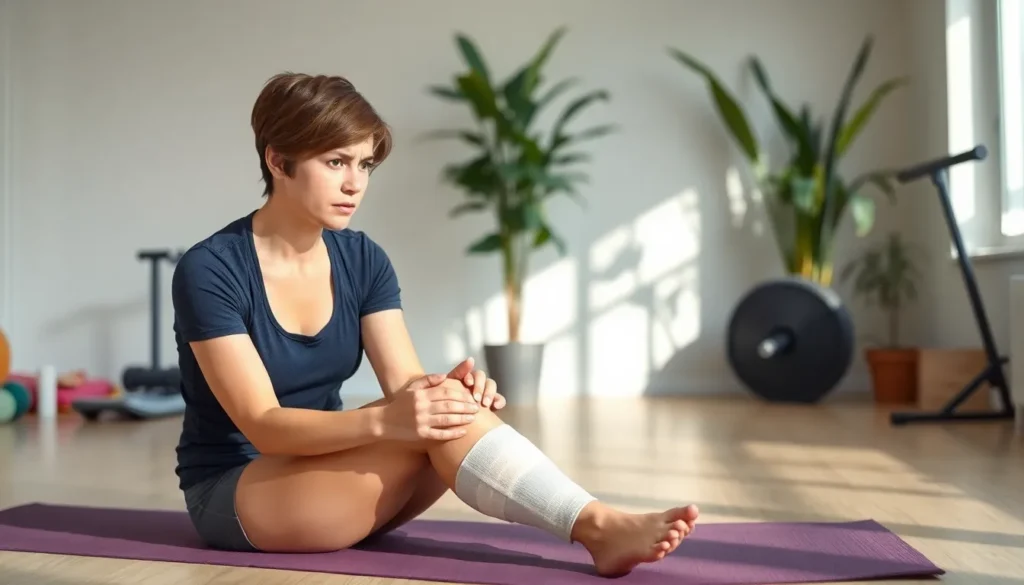Table of Contents
ToggleA sprained knee can feel like a bad joke—one moment you’re strutting your stuff, and the next, you’re hobbling around like a three-legged giraffe. It’s frustrating when a simple twist turns into a full-blown drama. But don’t worry, self-care is here to save the day! With the right tips and tricks, healing doesn’t have to be a pain in the knee.
Understanding Sprained Knee Injuries
Sprained knees often result from sudden twisting movements or direct blows. Knowing the types and symptoms of knee sprains helps in effective self-care and recovery.
Types of Knee Sprains
Three primary types of knee sprains exist and vary in severity. The first type is a mild sprain, often involving slight stretching of ligaments with minimal damage. The second type is a moderate sprain, where ligaments experience partial tearing, leading to increased instability. The third is a severe sprain, characterized by complete ligament tears and significant joint instability. Each type requires tailored self-care strategies for optimal recovery.
Symptoms of a Sprained Knee
Symptoms of a sprained knee can differ based on injury severity. Common symptoms include swelling around the joint, which often develops quickly. Pain occurs during movement, making it difficult to walk or put weight on the affected leg. Additionally, individuals may notice tenderness along the knee and may experience limited range of motion. Bruising can also surface within the initial days following the injury, indicating tissue damage.
Immediate Self-Care Measures

Immediate self-care measures play a crucial role in managing a sprained knee effectively. Implementing these strategies can help reduce pain and swelling while promoting healing.
RICE Method
RICE stands for Rest, Ice, Compression, and Elevation. Resting the knee prevents further injury and allows healing. Applying ice for 15 to 20 minutes at a time helps reduce swelling. Compression with an elastic bandage provides support and limits movement. Elevating the knee above heart level aids blood circulation and minimizes swelling. Following this method consistently in the first 48 hours after injury enhances recovery.
Pain Management Techniques
Pain management techniques help alleviate discomfort associated with a sprained knee. Over-the-counter medications like ibuprofen or acetaminophen can provide relief. Topical analgesics may offer localized pain control when applied directly to the knee. Gentle range-of-motion exercises maintain mobility without exacerbating pain. Additionally, using a knee brace can stabilize the joint and support the healing process. Prioritizing these pain management approaches aids in a smoother recovery journey.
Long-Term Self-Care Strategies
Long-term self-care strategies enhance recovery following a sprained knee. A focus on strengthening and stretching significantly improves knee function and stability.
Strengthening Exercises
Strengthening exercises play a vital role in rehabilitation. They target muscles around the knee, boosting support and reducing injury risk. Three effective exercises include squats, lunges, and leg raises. Squats build overall leg power; lunges improve balance and coordination; leg raises isolate quadriceps for muscle growth. Perform these exercises 2-3 times weekly, gradually increasing intensity as strength develops. Consistency fosters faster recovery and restores mobility.
Stretching Activities
Stretching activities improve flexibility and prevent stiffness. They maintain range of motion after a sprain. Key stretches consist of hamstring stretches, quadriceps stretches, and calf stretches. Hamstring stretches promote leg flexibility; quadriceps stretches enhance knee extension; calf stretches assist in ankle mobility. Hold each stretch for 20-30 seconds, repeating 2-3 times per activity. Regular stretching enhances overall recovery, ensuring the knee remains functional during the healing process.
When to Seek Medical Attention
Recognizing when to seek medical help for a sprained knee can significantly influence recovery. Certain signs may indicate a severe injury requiring professional evaluation.
Signs of Severe Injury
Experiencing intense pain that doesn’t subside with rest may point to a more serious issue. Swelling that rapidly increases, often larger than the opposite knee, signals potential complications. Inability to put weight on the affected leg or fully extend the knee suggests serious damage. Visible deformity, such as an unnatural angle, should prompt immediate medical attention. Joint instability or a feeling of “giving way” during movements can also indicate severe injury.
Professional Treatments Available
Medical professionals may recommend imaging tests like X-rays or MRIs to assess the extent of the injury. Depending on the severity, treatments can include physical therapy to restore function. In some cases, a brace may be necessary for support during the healing process. For significant injuries, surgical options could be considered to repair torn ligaments. Prescription medications may also provide relief from pain and inflammation, aiding the recovery journey.
Self-care plays a vital role in recovering from a sprained knee. By implementing the RICE method and engaging in appropriate exercises, individuals can significantly enhance their healing process. Staying proactive about pain management and incorporating strengthening and stretching routines can lead to improved mobility and reduced risk of future injuries.
Recognizing when to seek professional help is equally important. Awareness of severe symptoms ensures timely medical intervention, which can further support recovery. With patience and dedication to self-care strategies, individuals can regain their strength and return to their active lifestyles.







